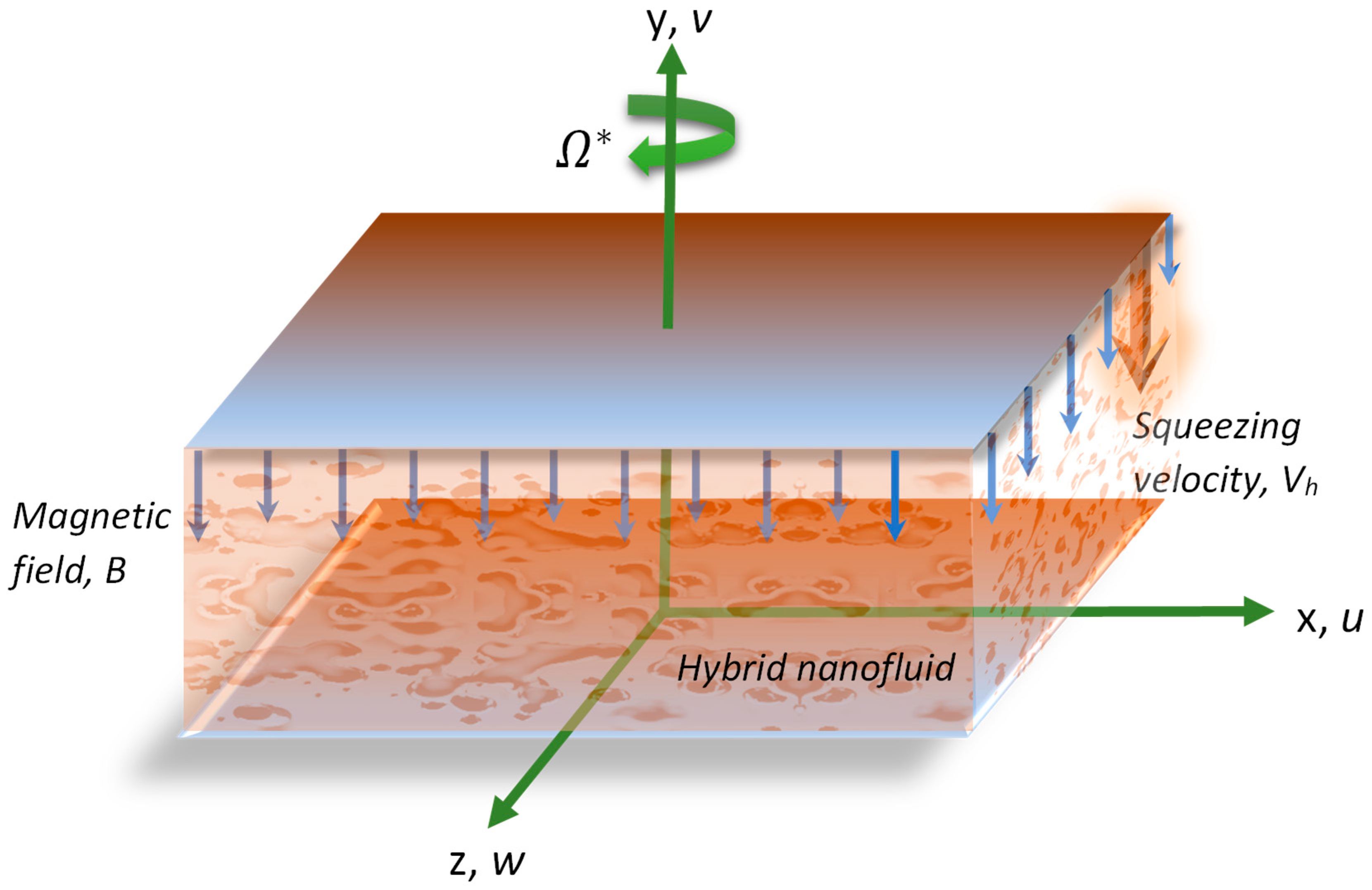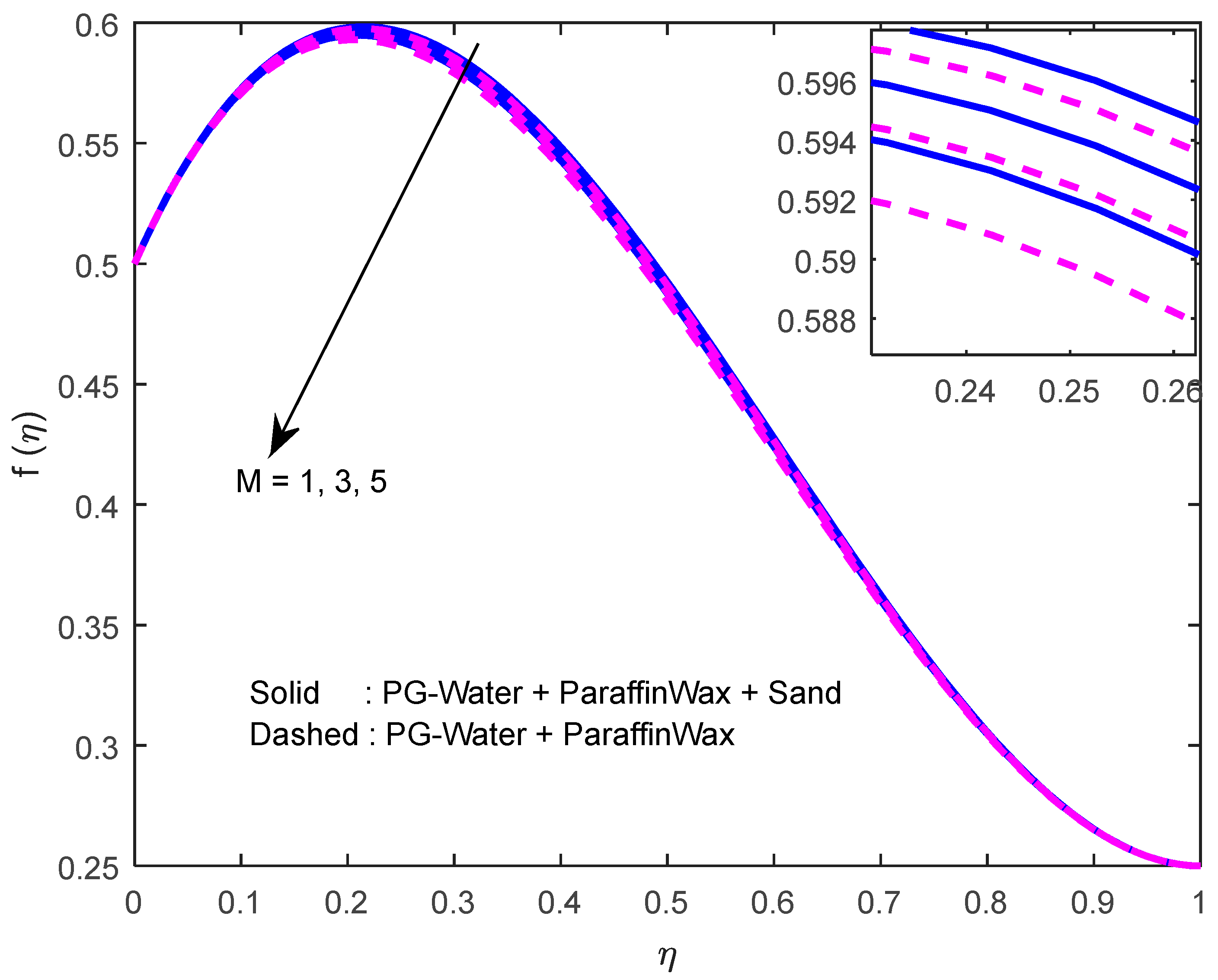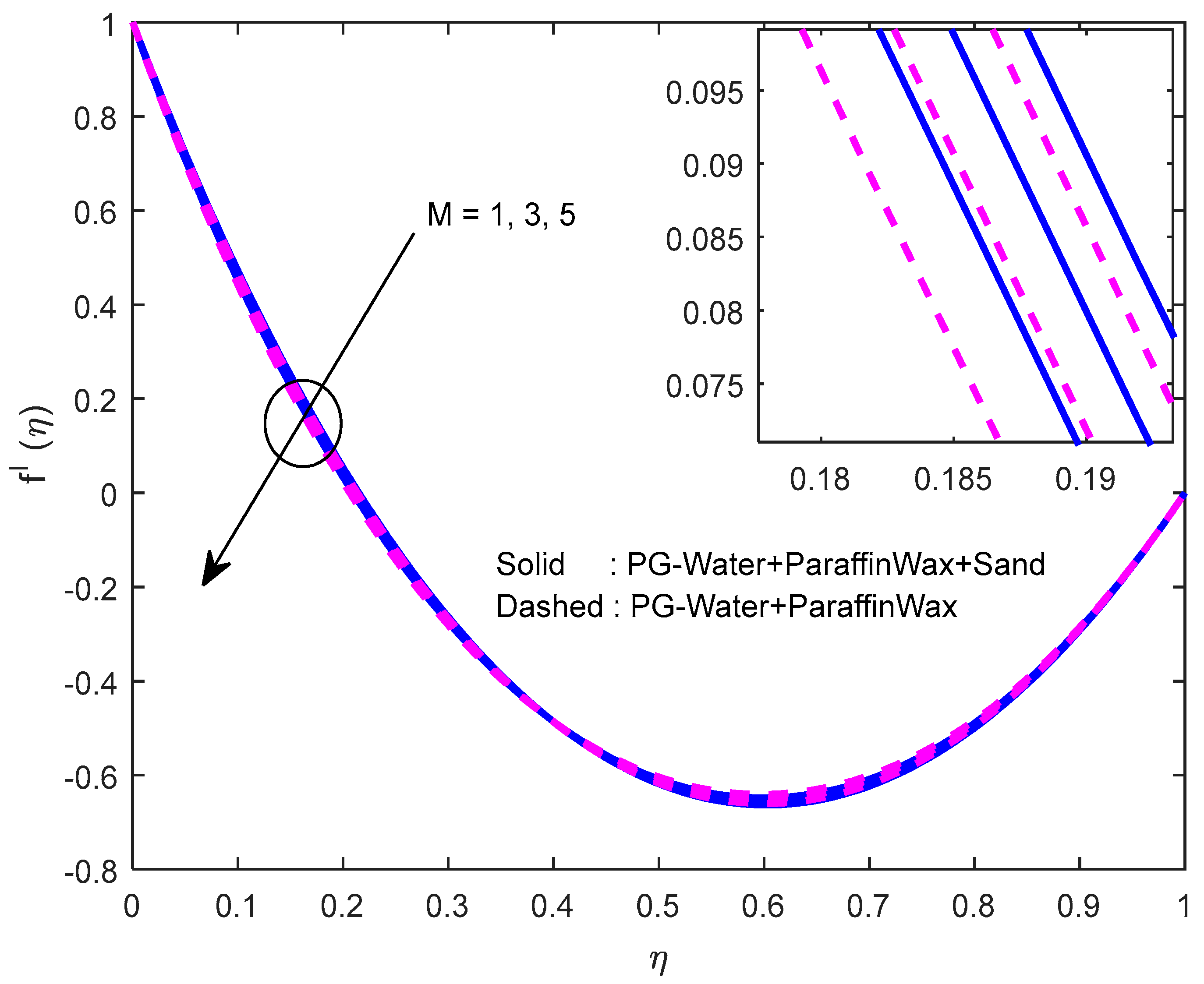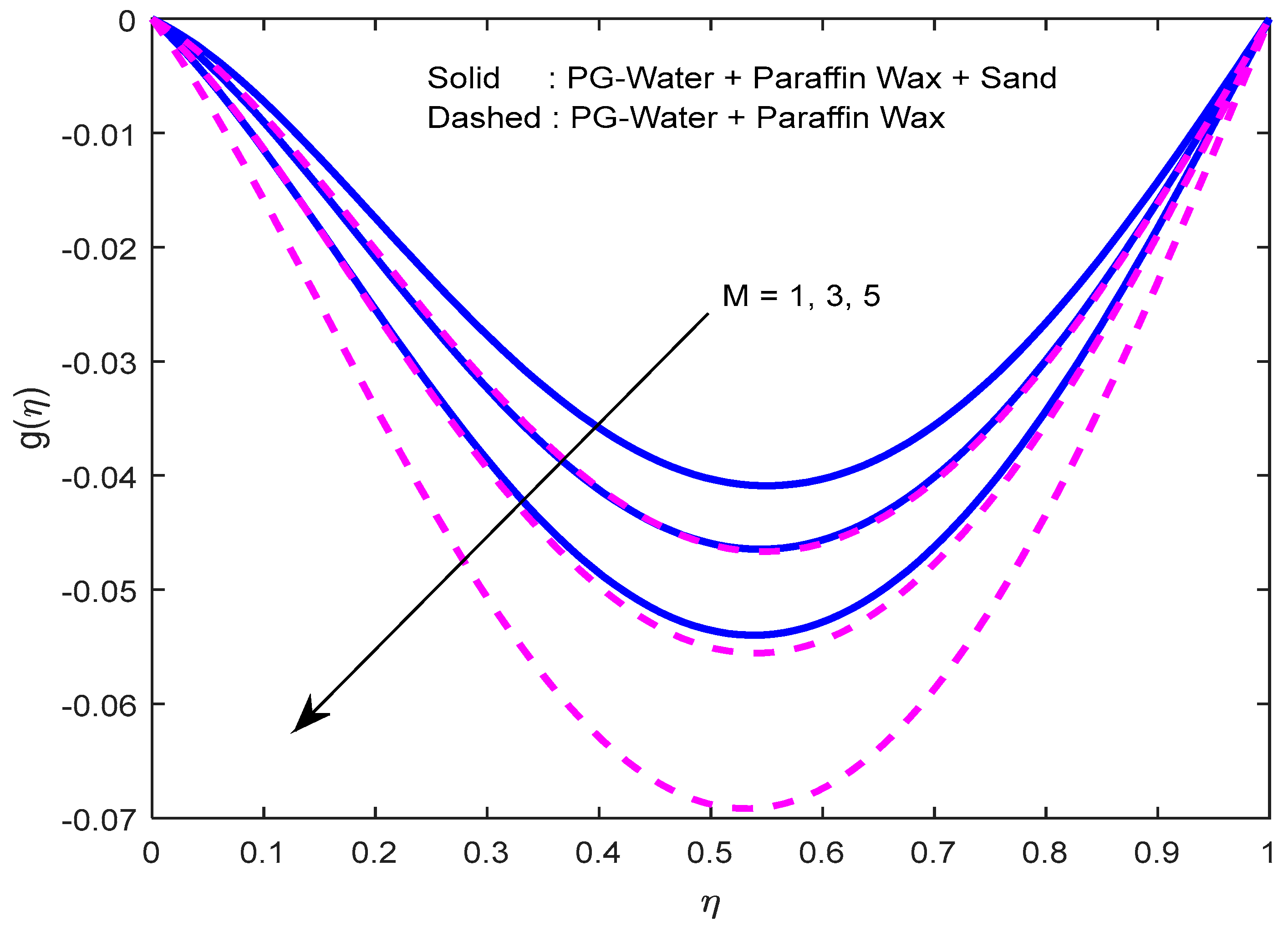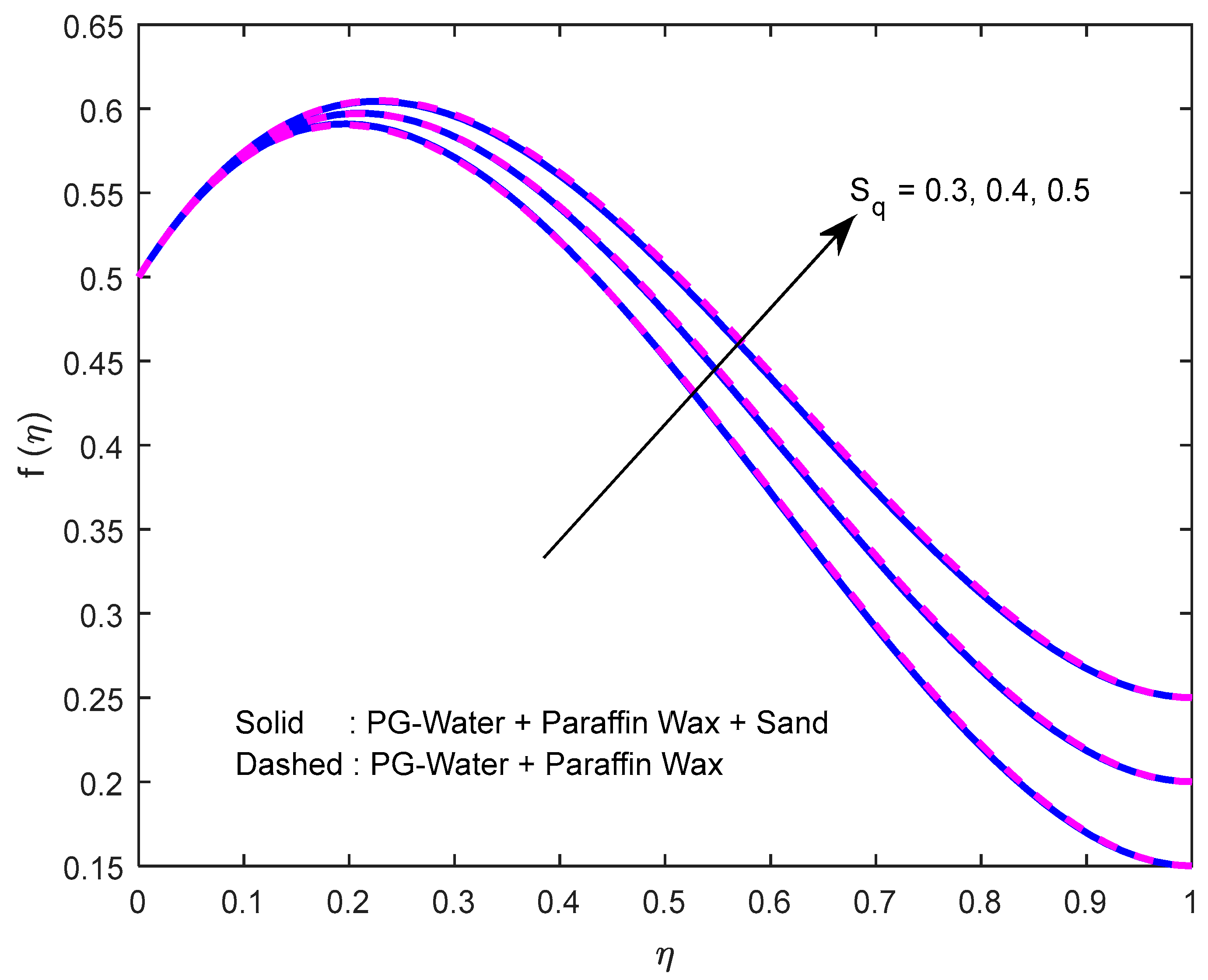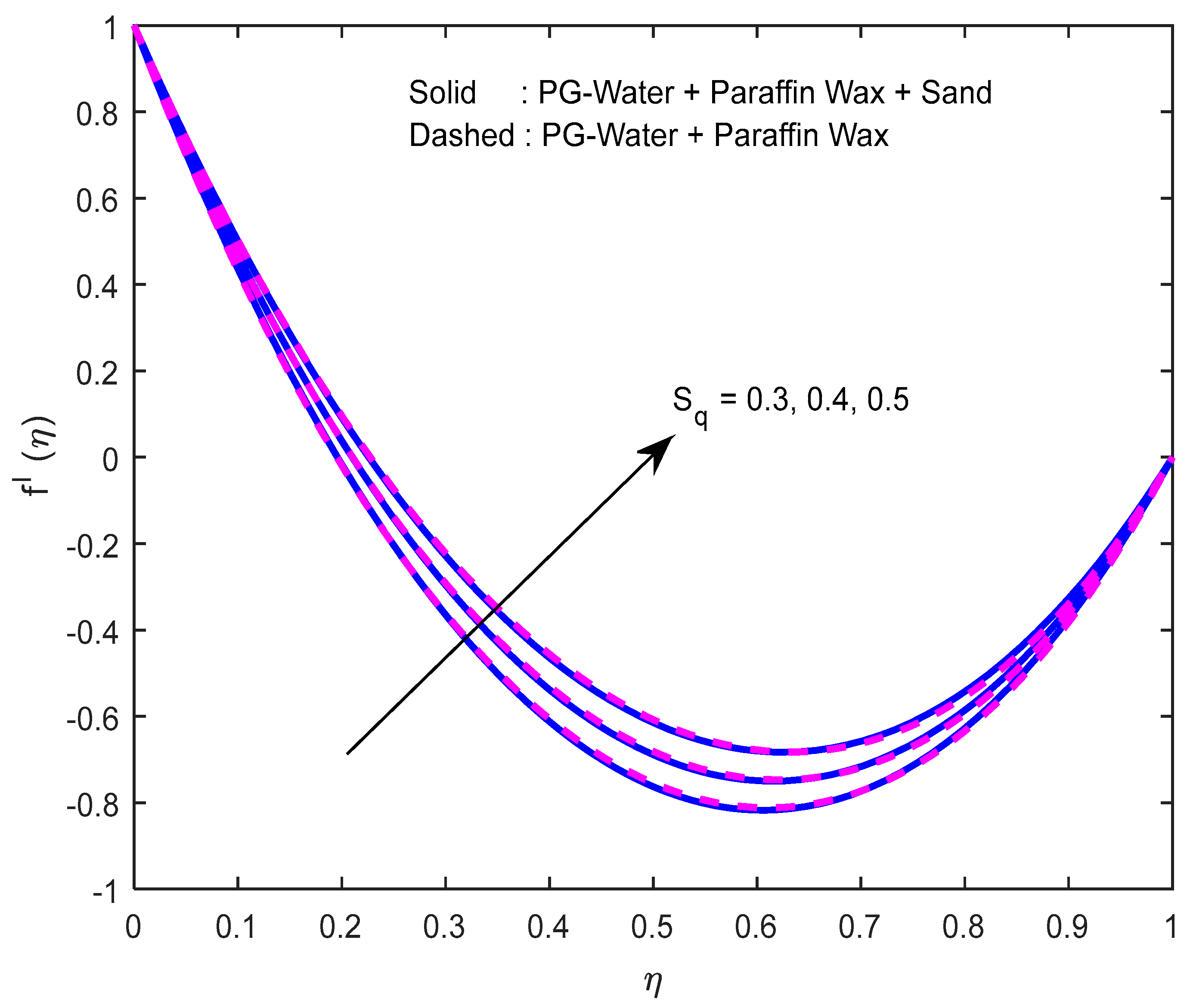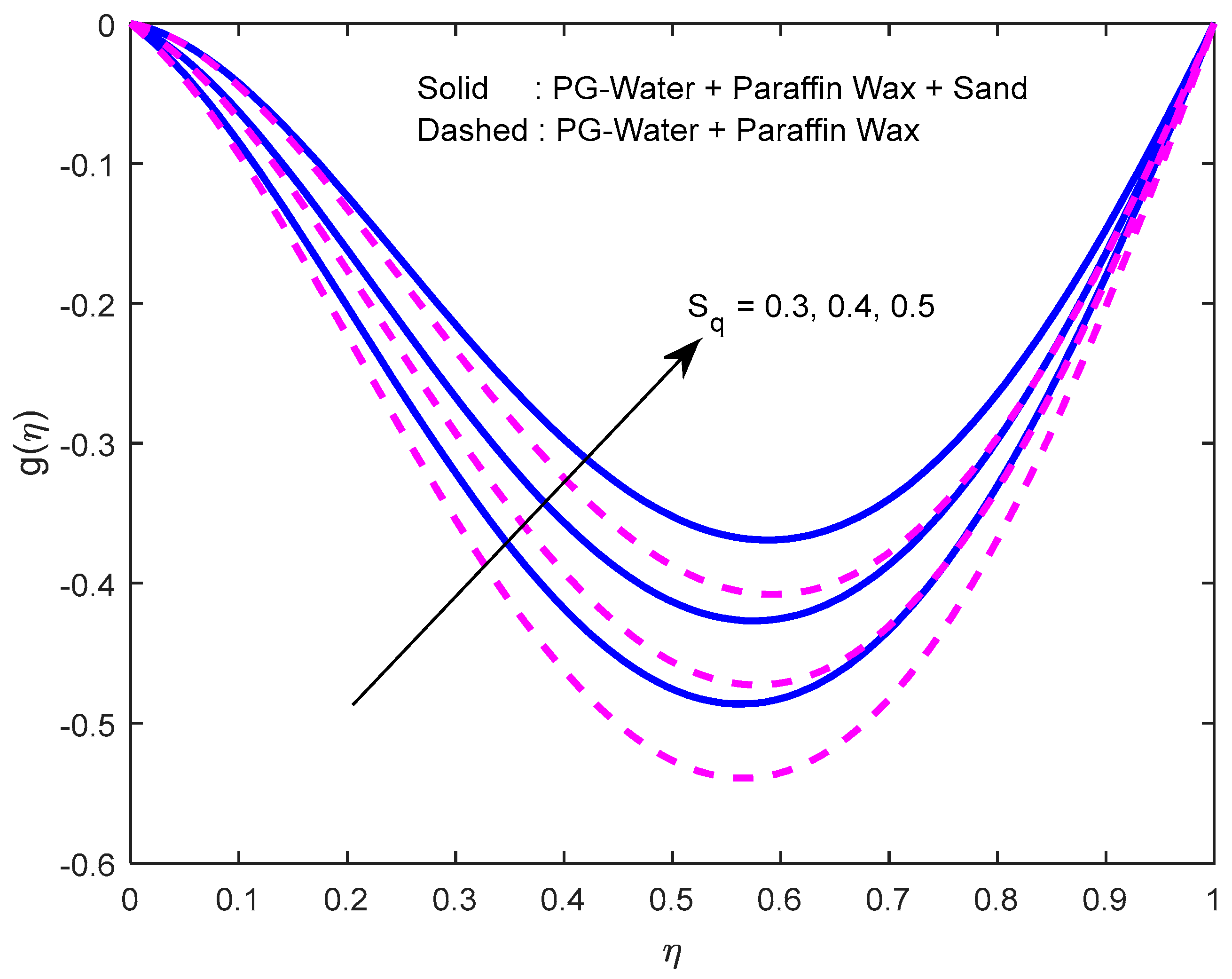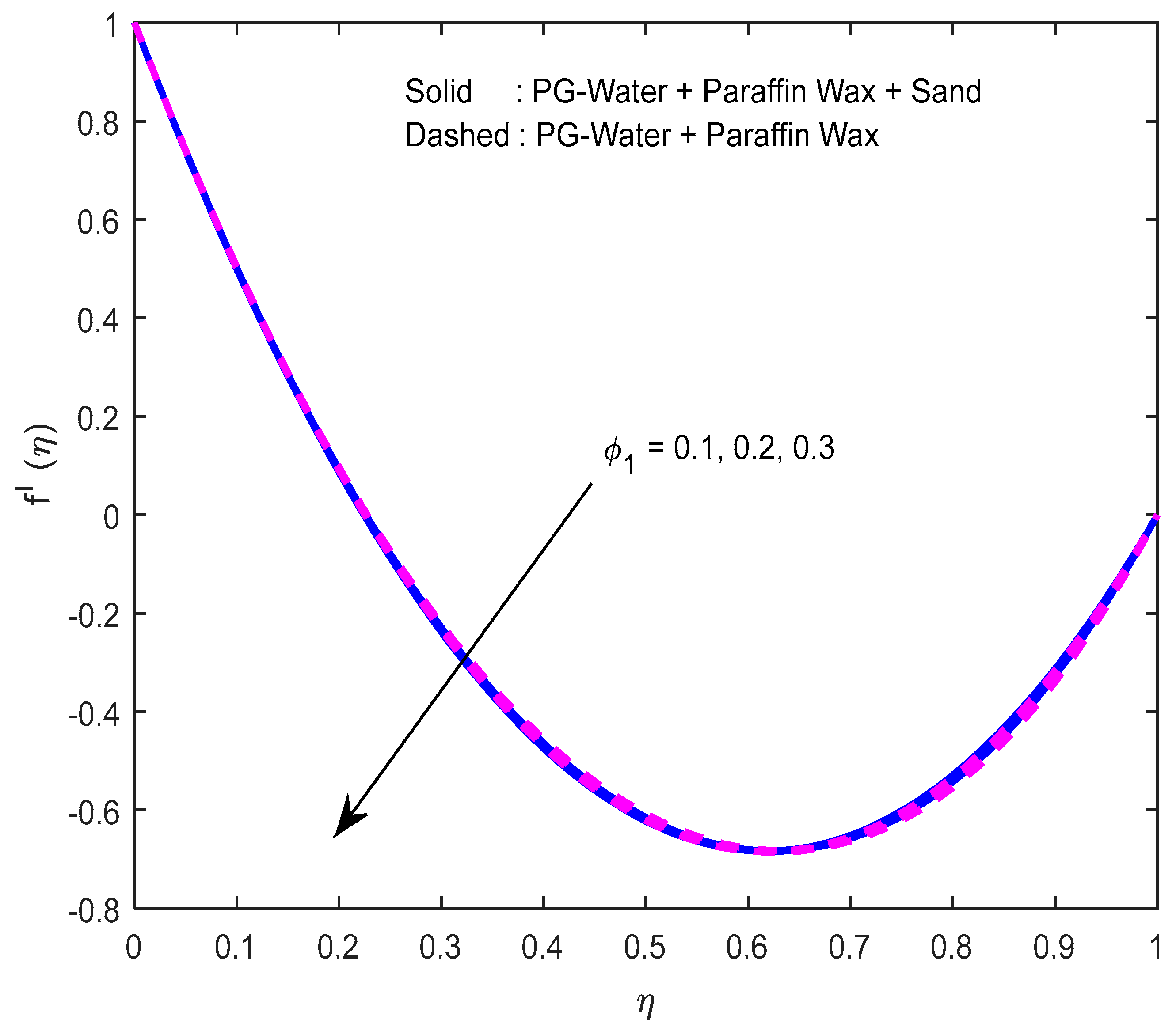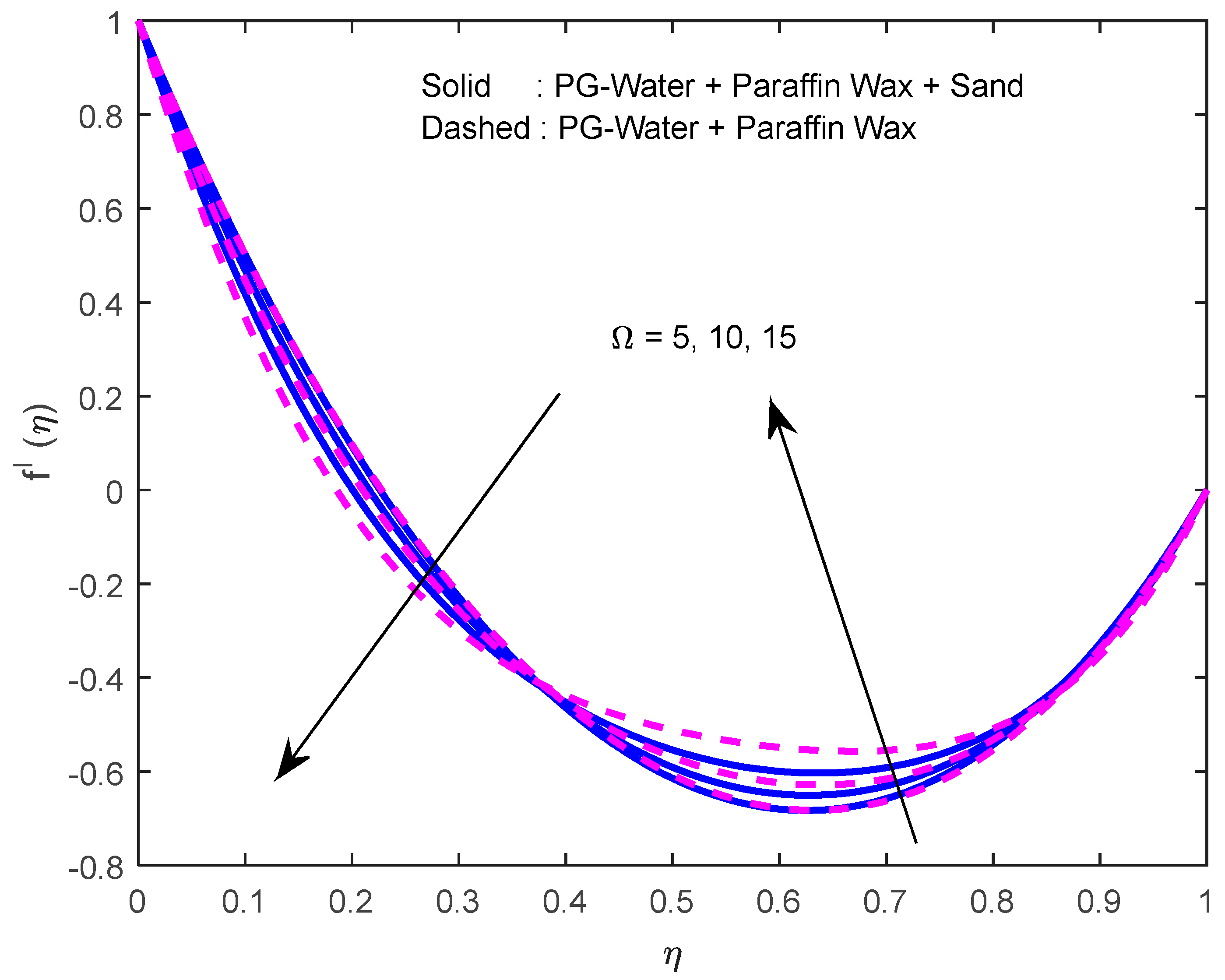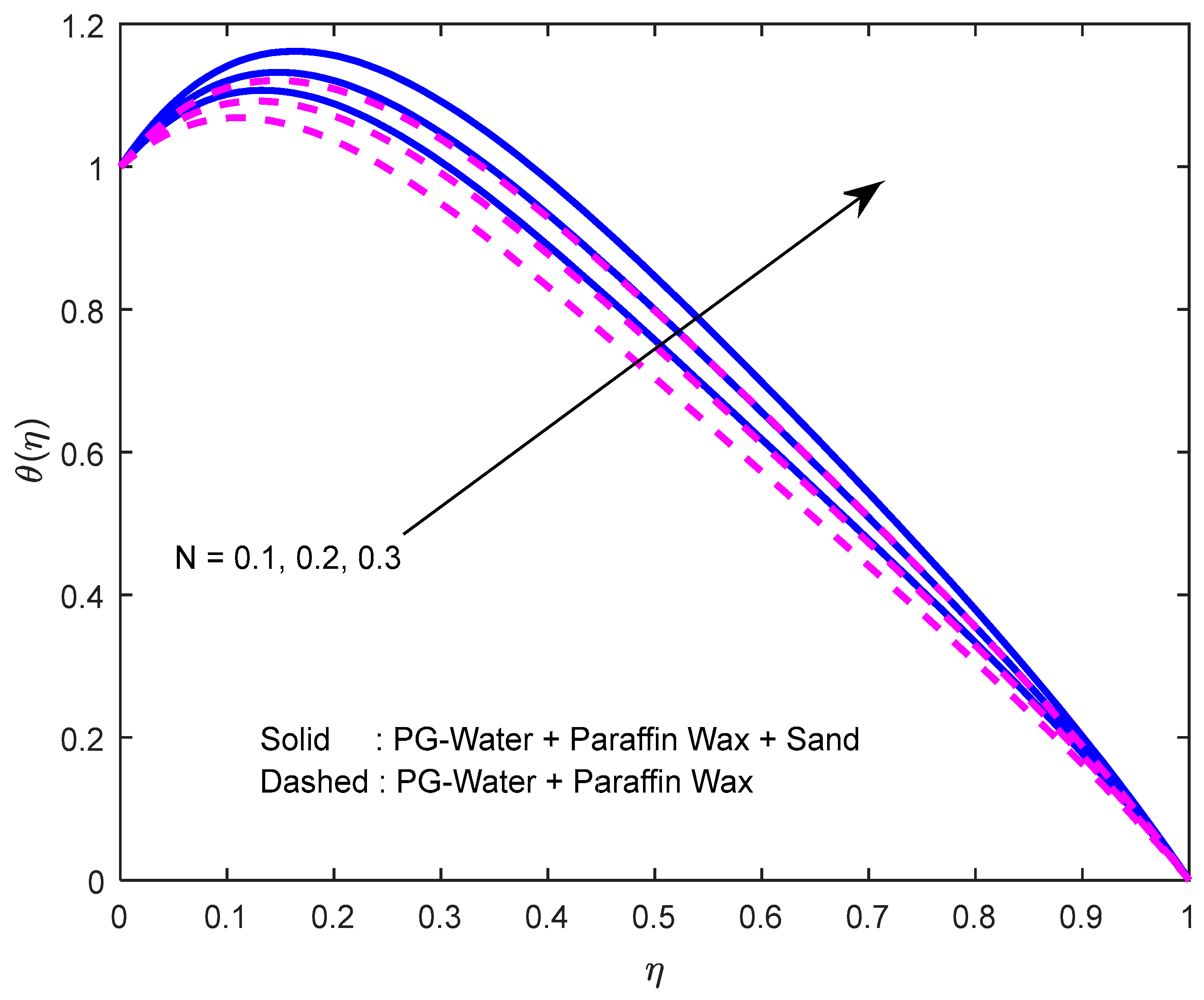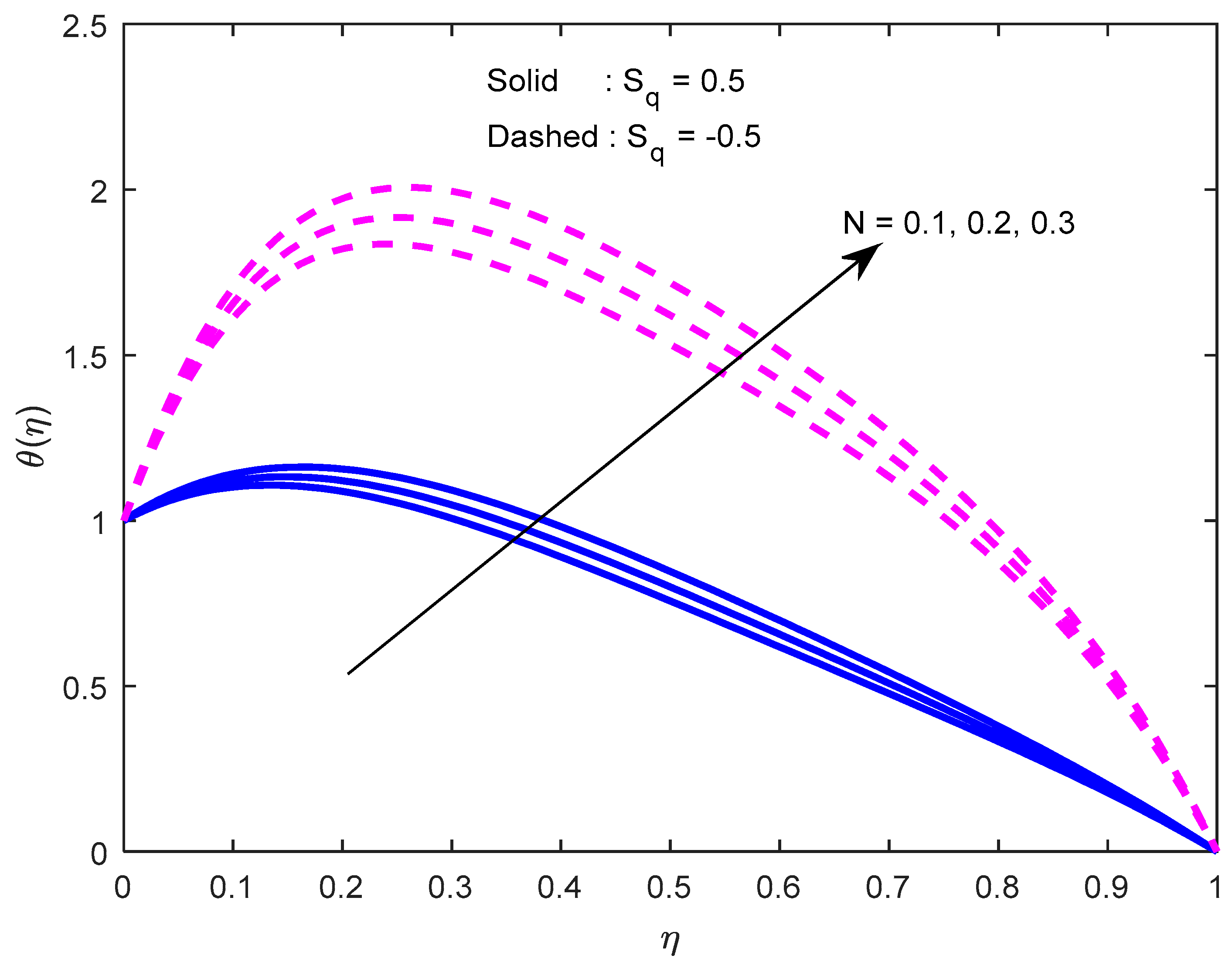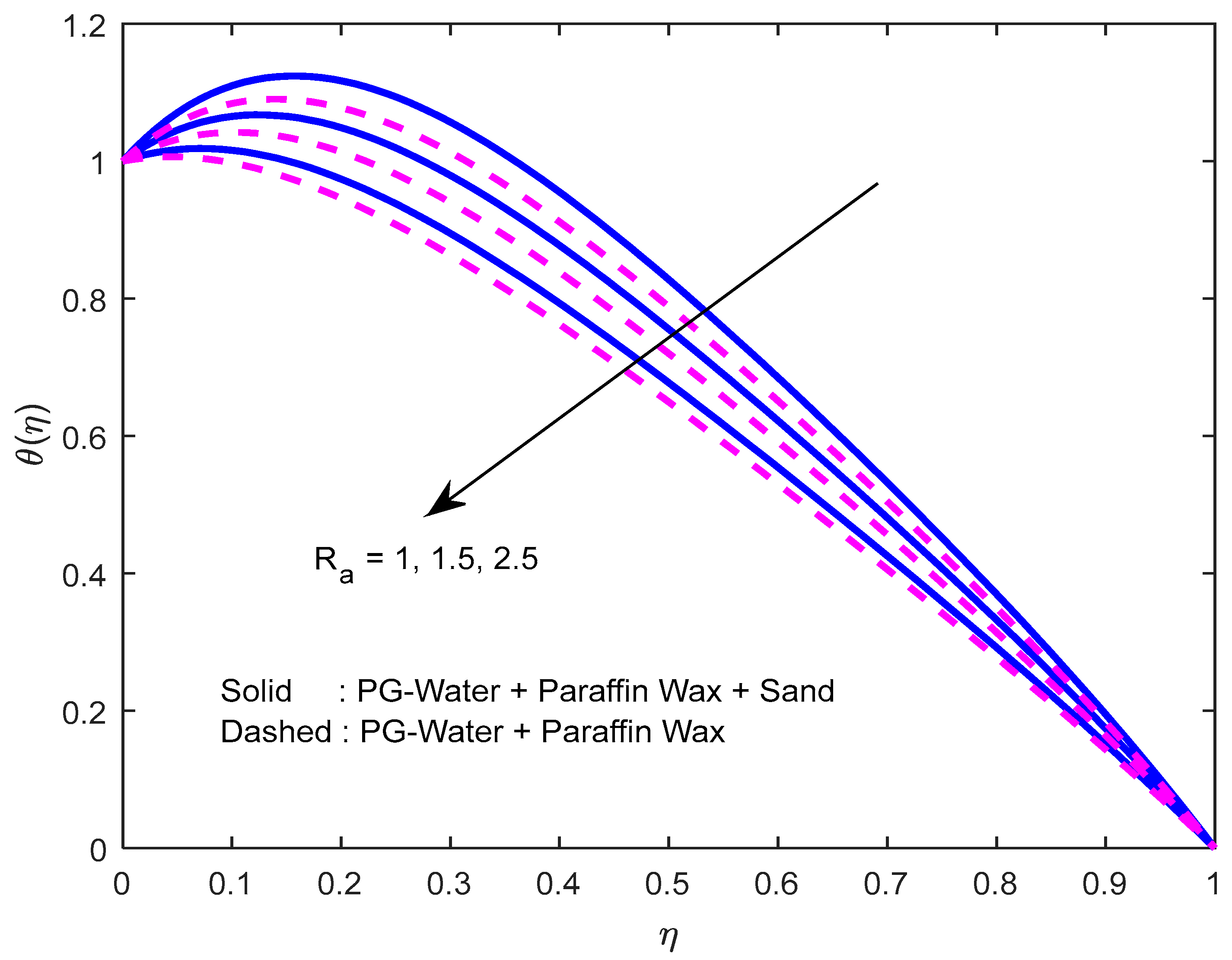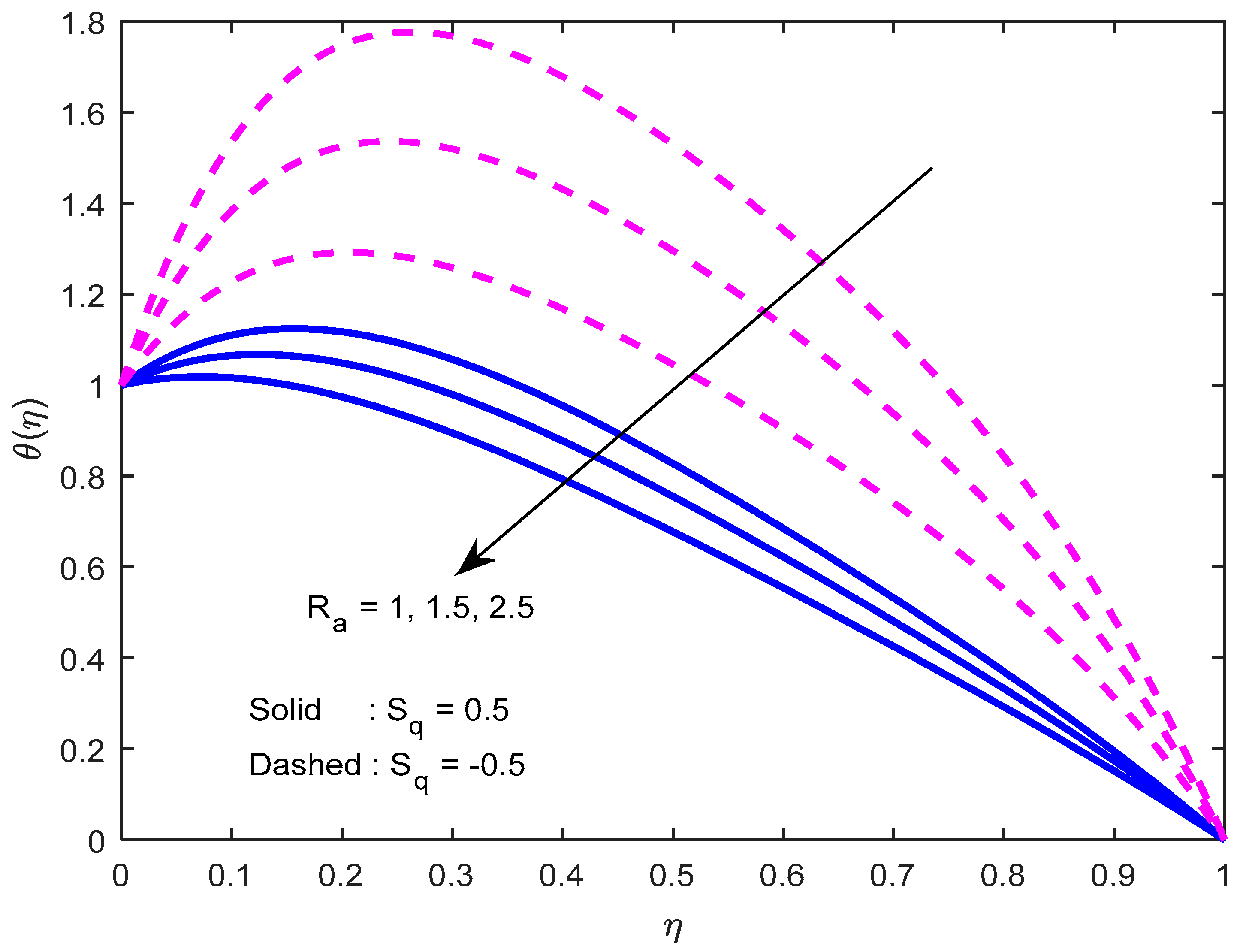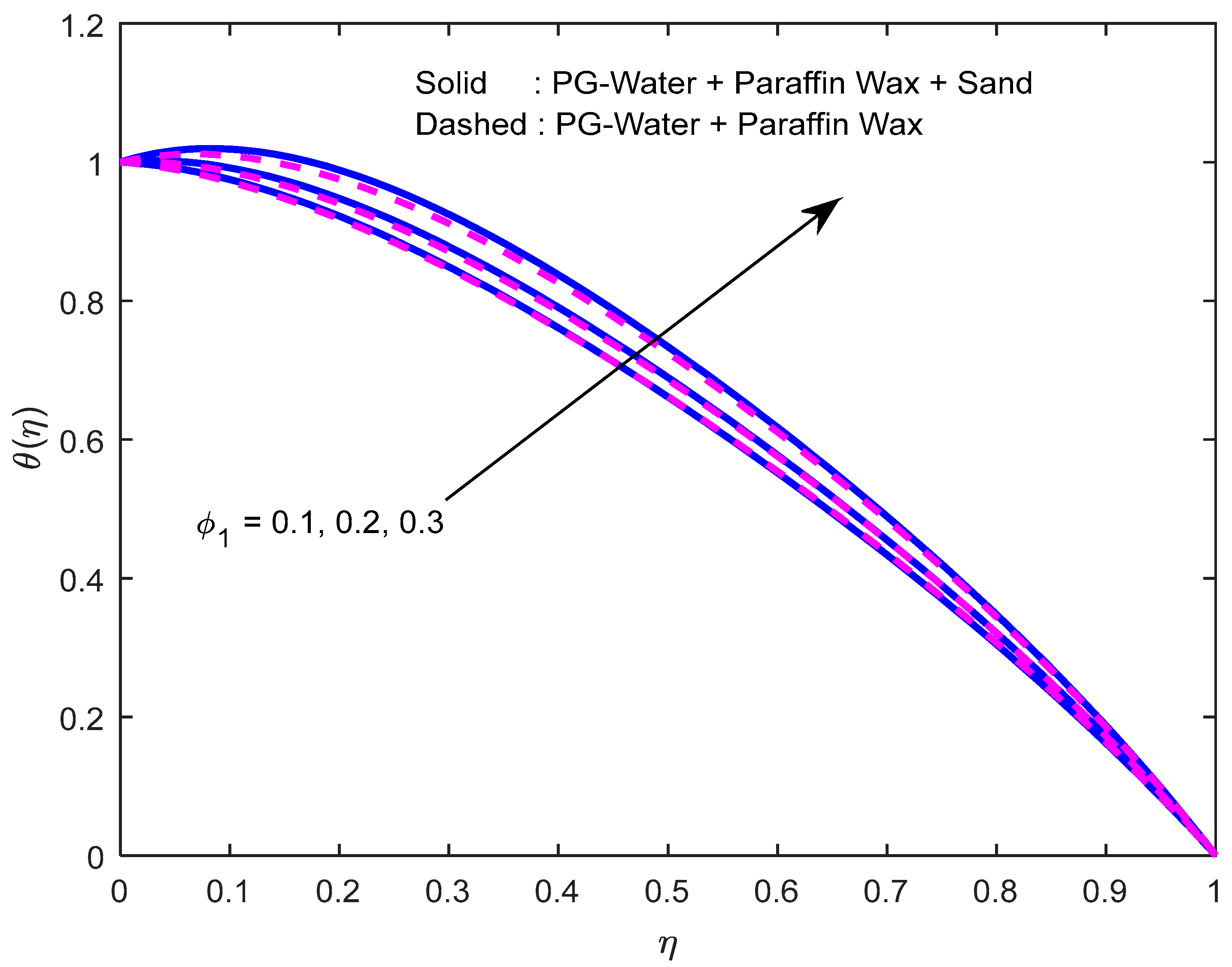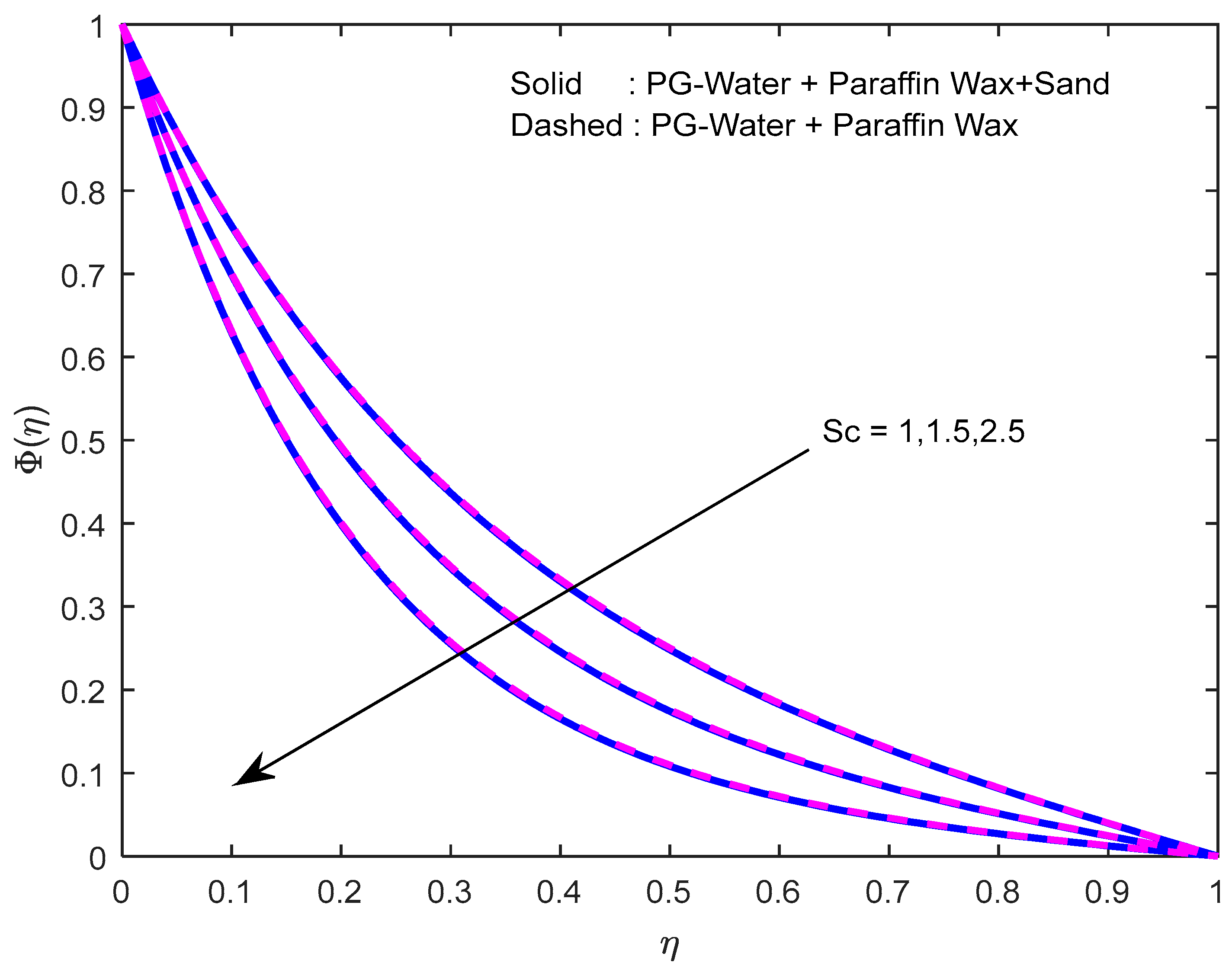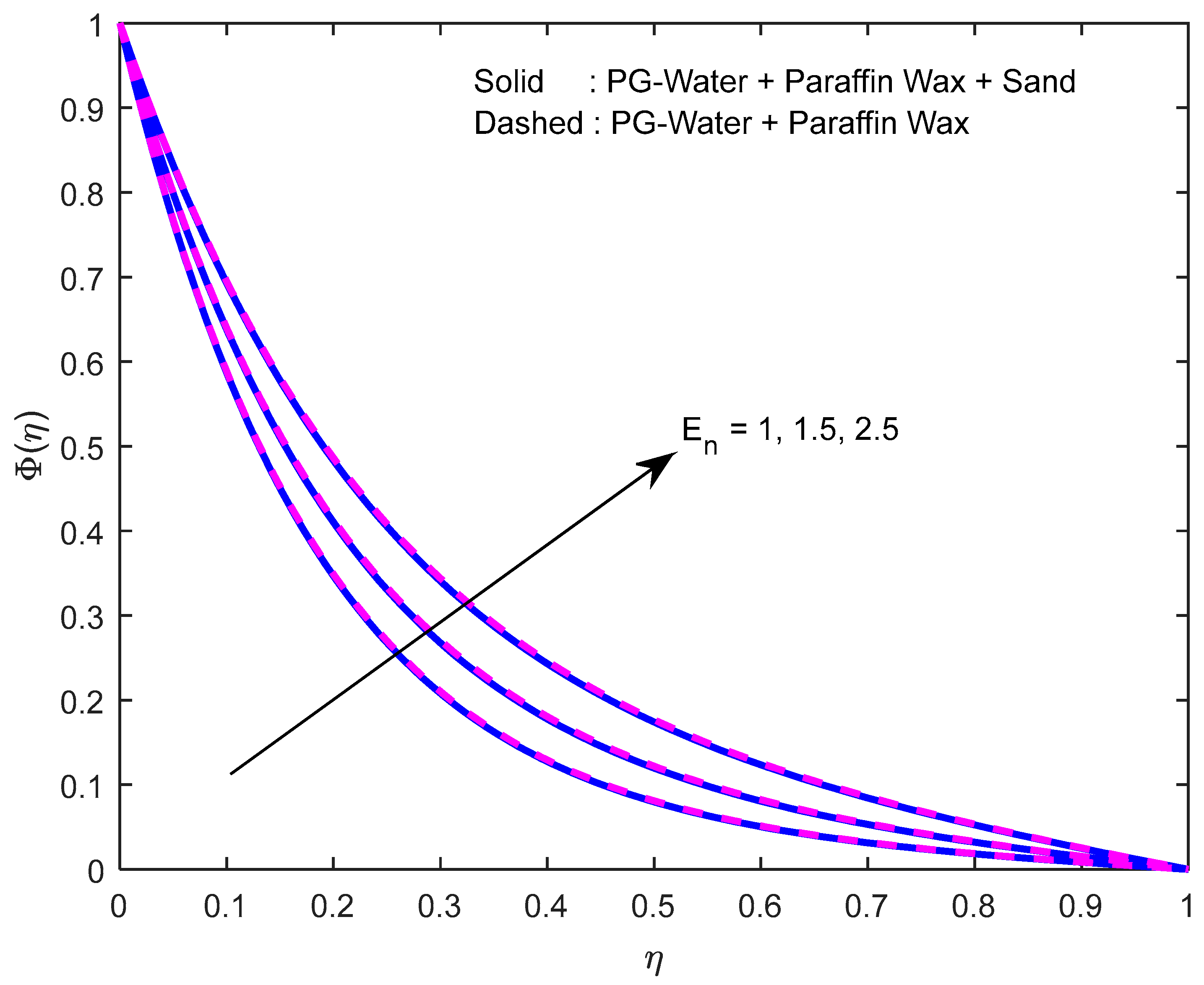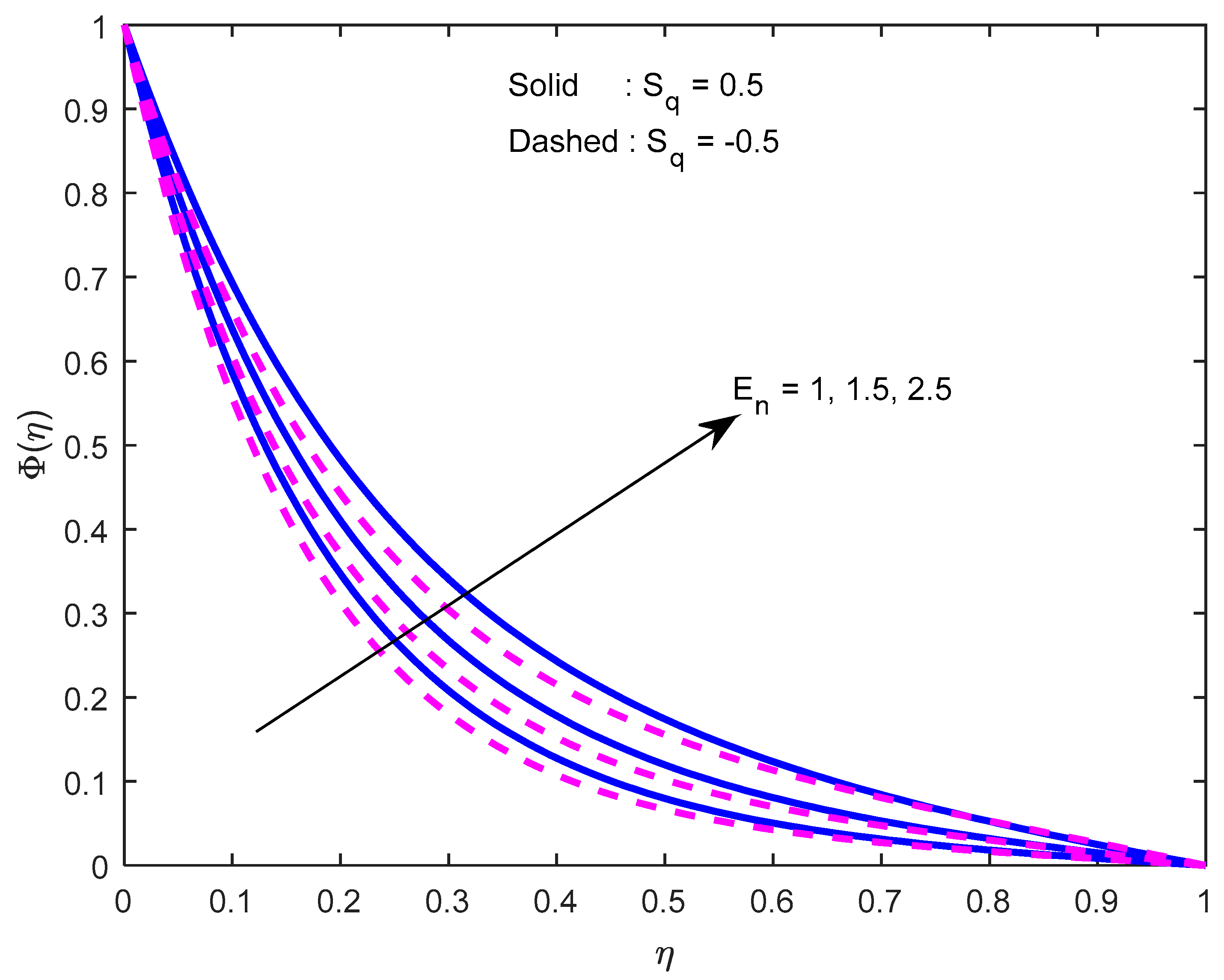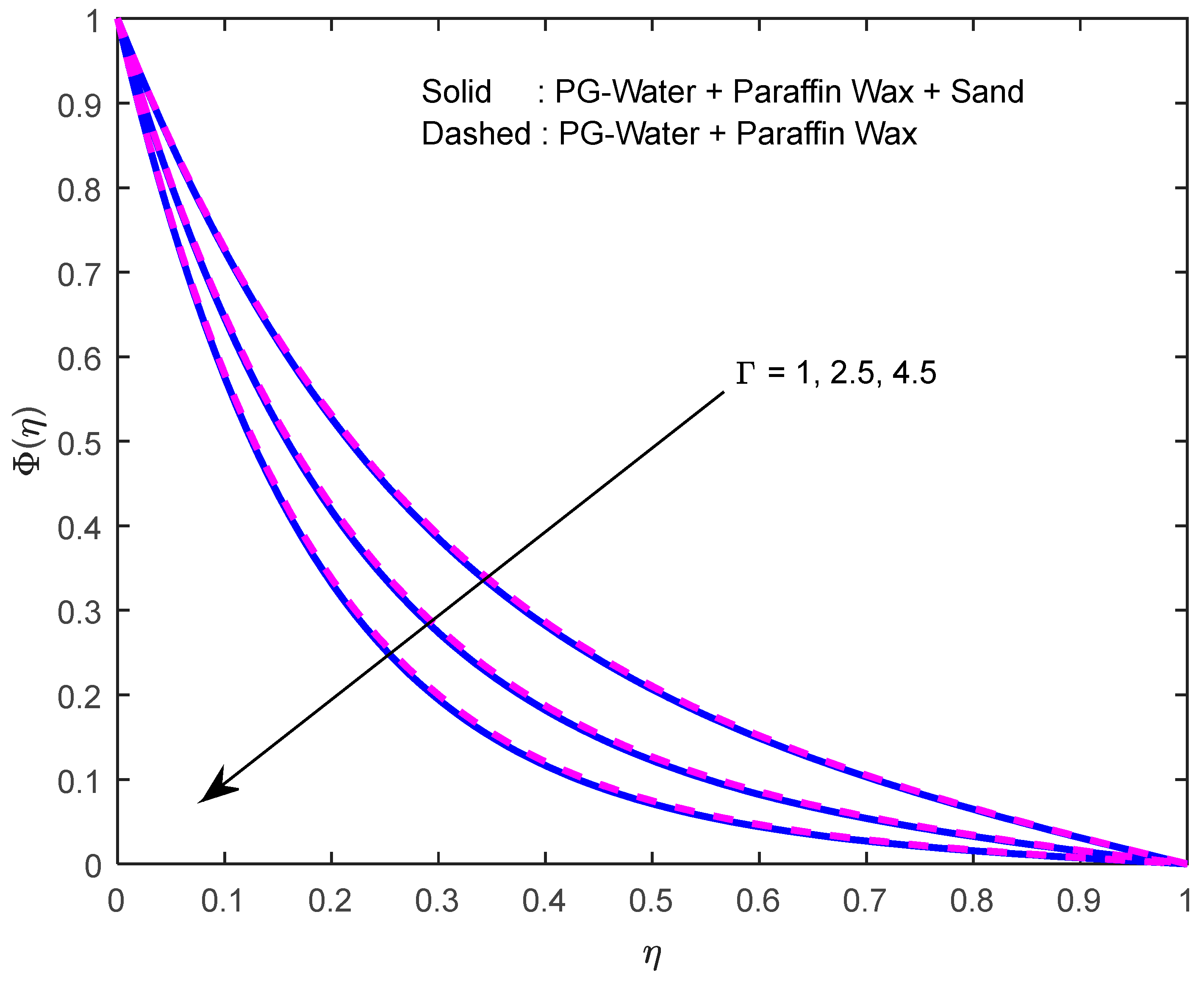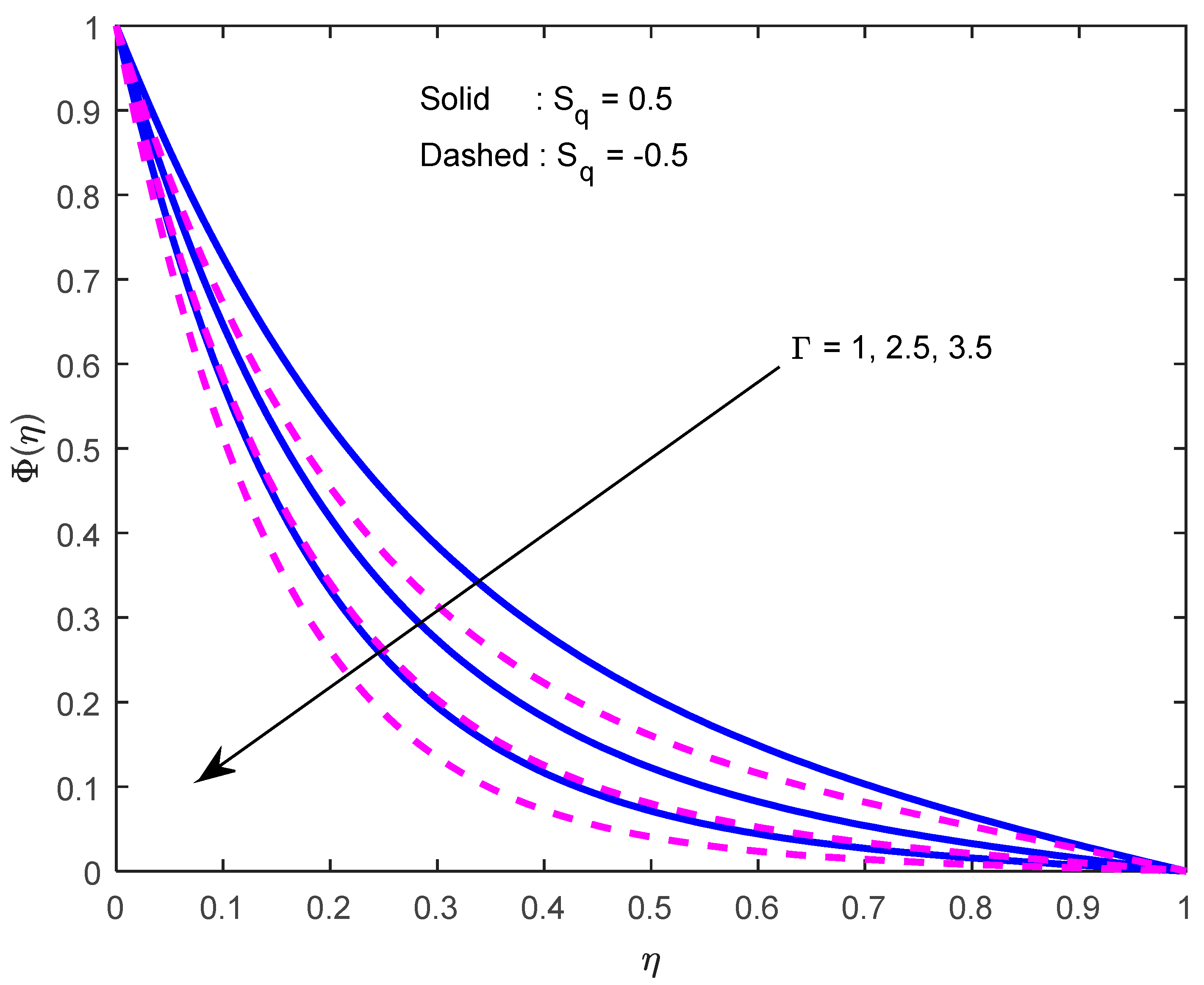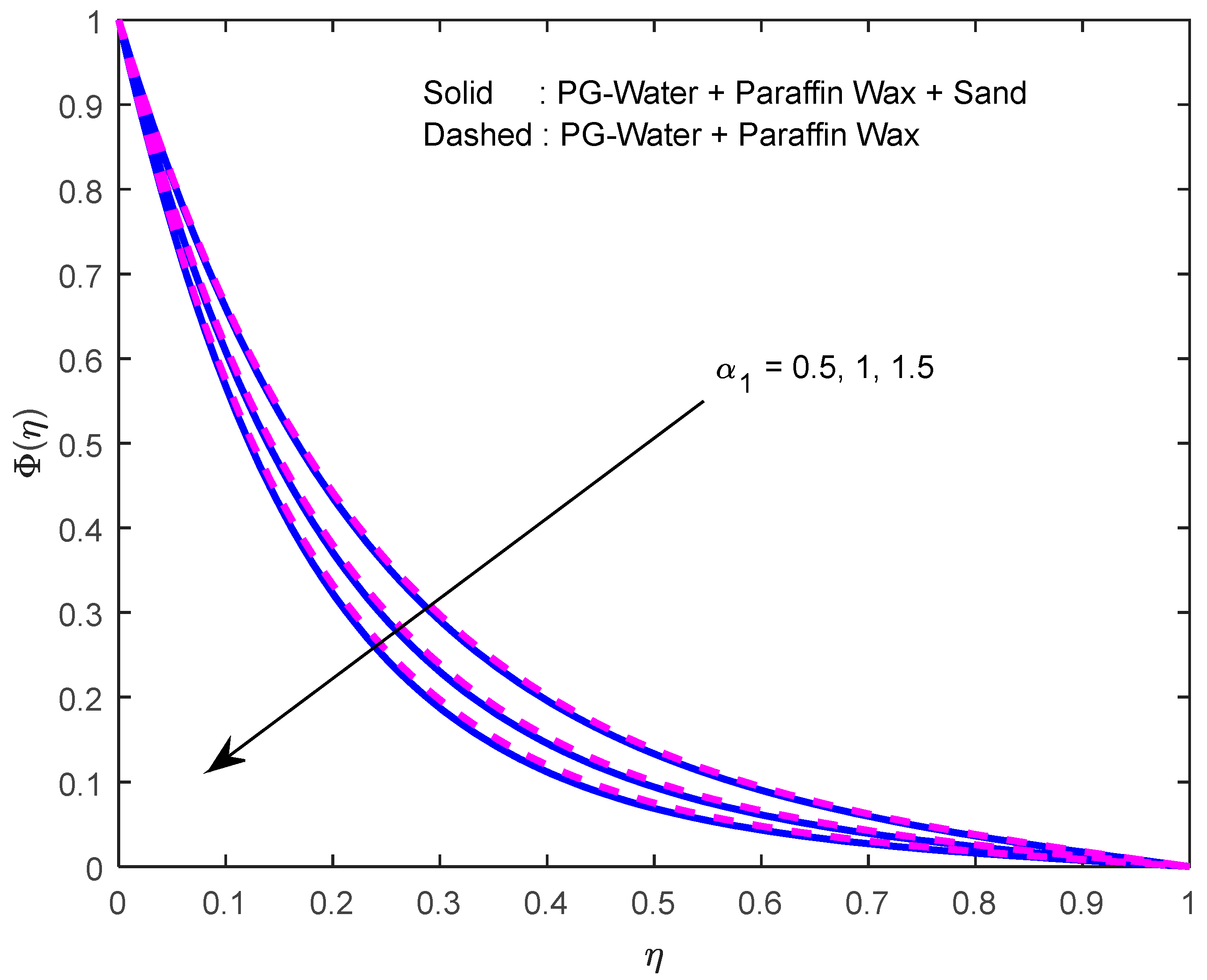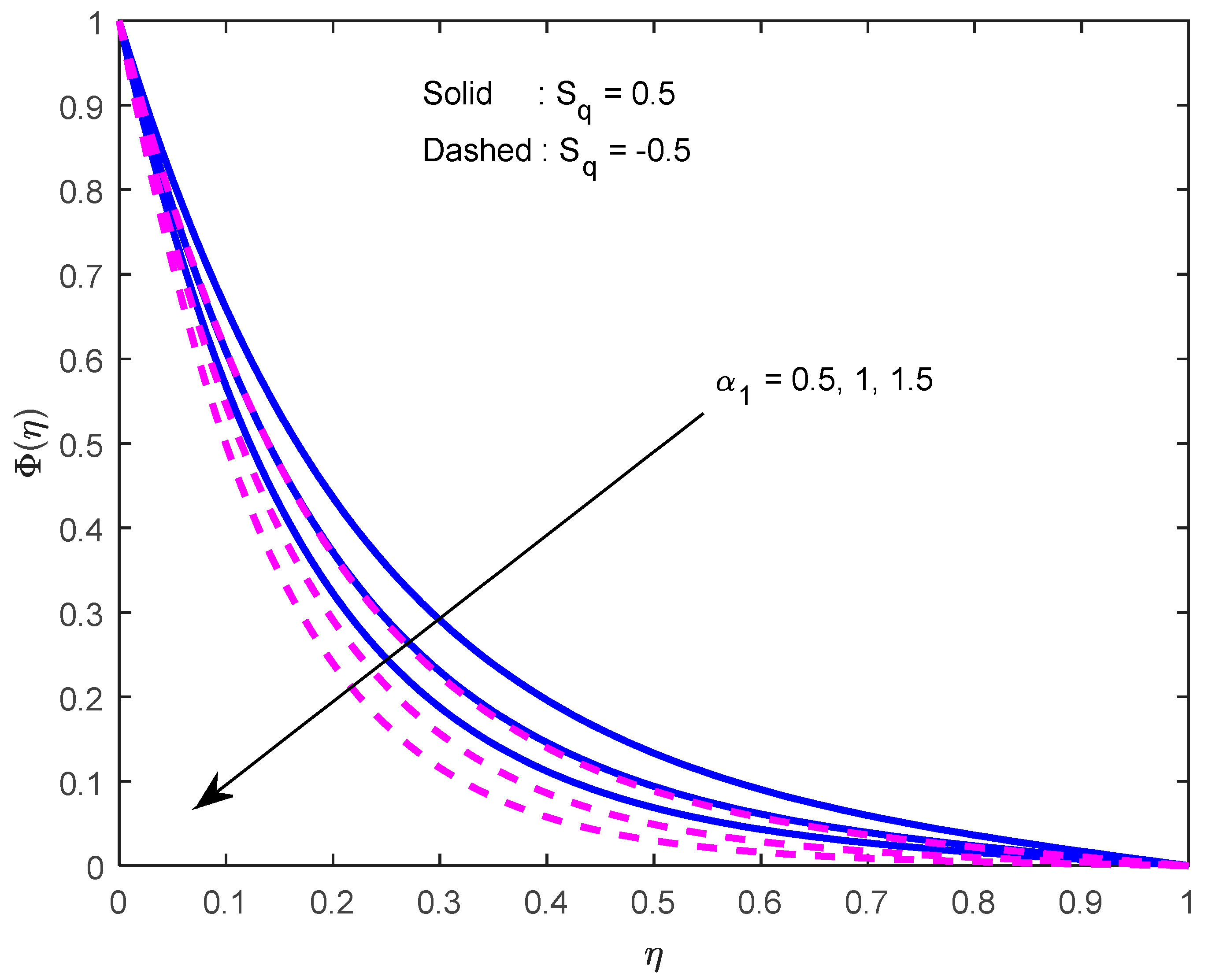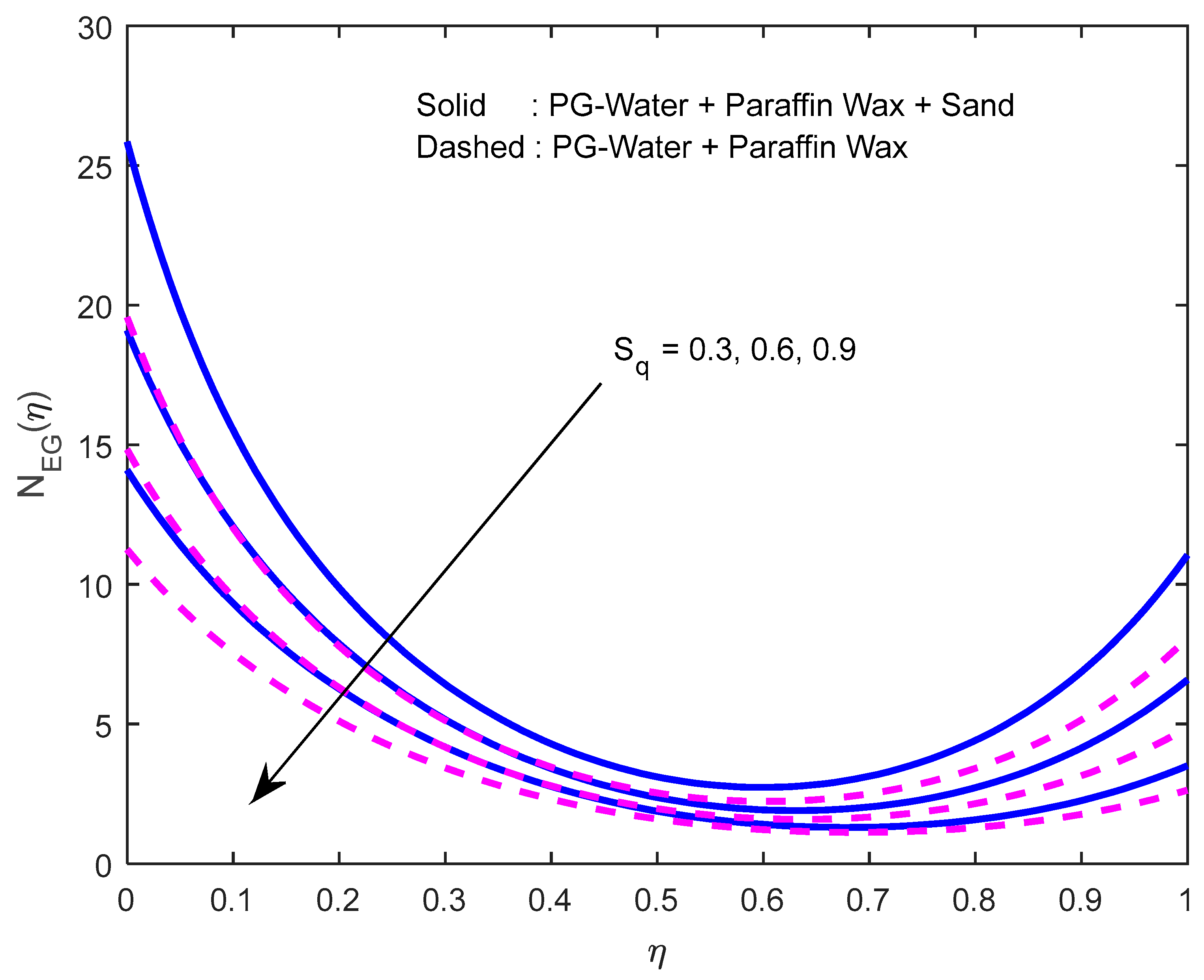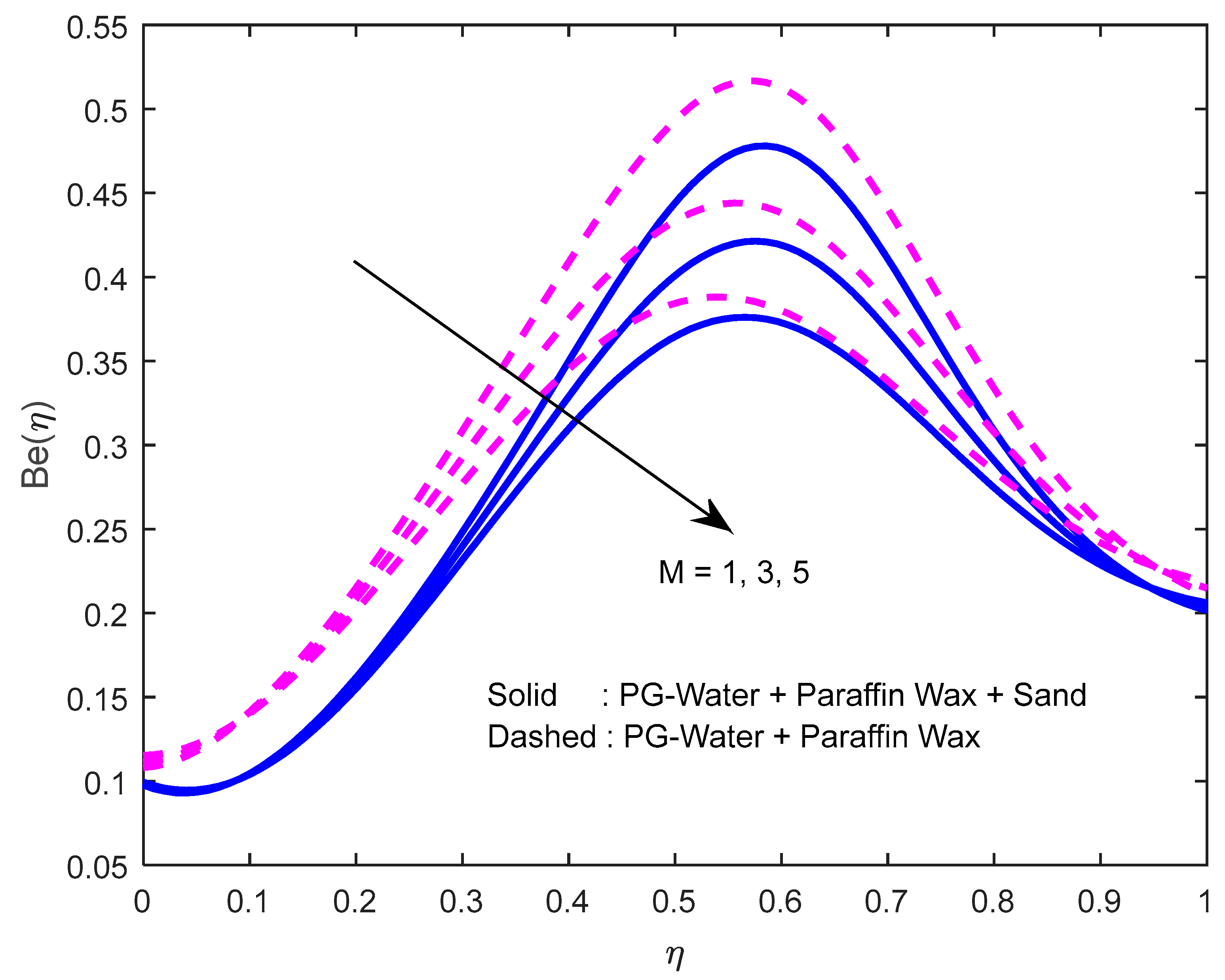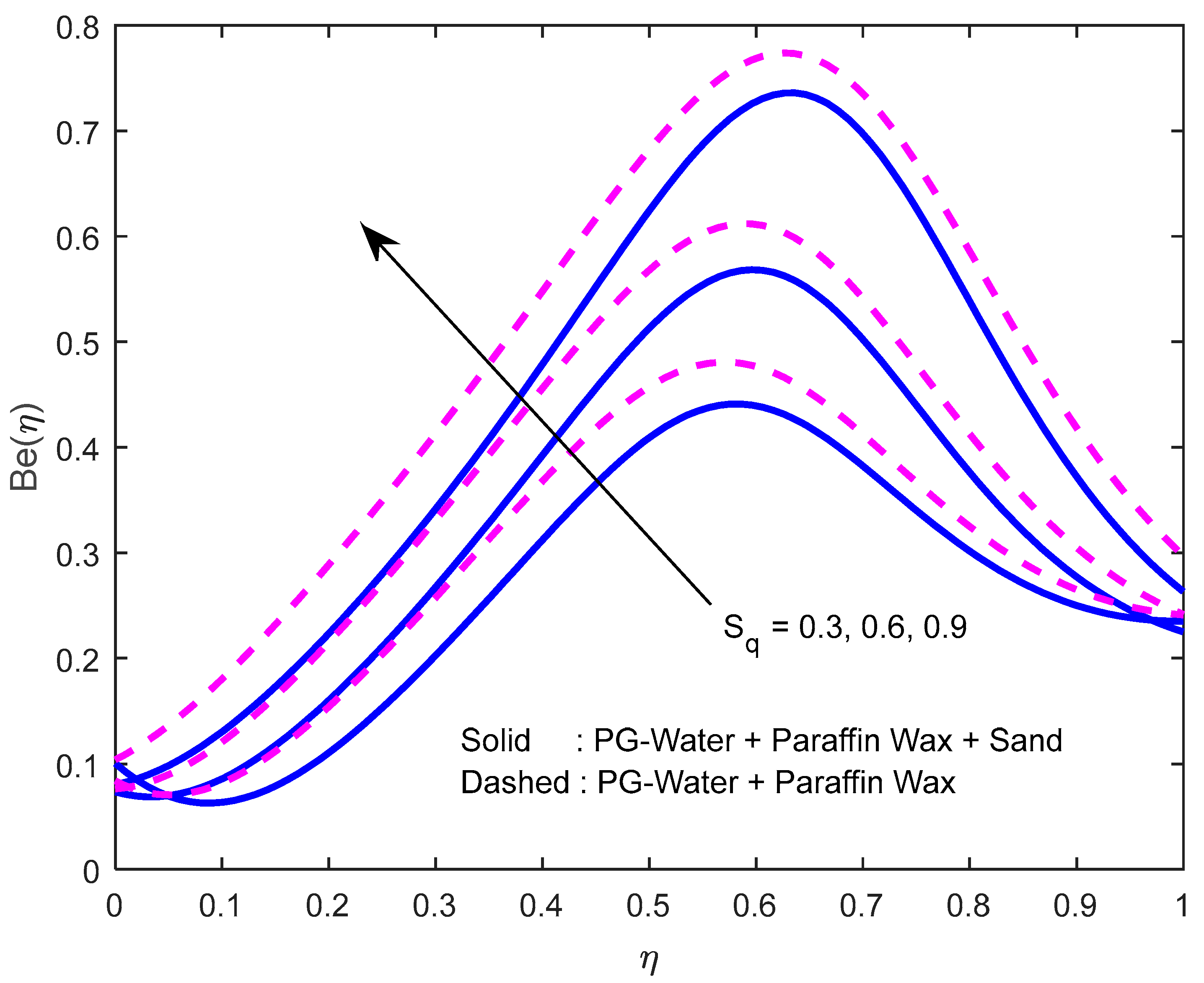1. Introduction
Squeezing flow is defined as a flow where the material is squeezed out or disfigured in two parallel plates. The flow is useful in various fields, for instance, in welding engineering and rheometry. In addition, utilizing nanofluids in various industrial applications is extensively investigated for augmented heat transfer characteristics. Squeeze flow is an attractive technique for measuring the rheological properties of materials that create difficulties in conventional rheometers, for example, very viscous materials, fluids with an apparent yield stress, fluids that tend to slip at instrument walls, or materials with large particles ( these characteristics often appear together) (Engmann et al. [
1]). Su and Yin [
2] analyzed the squeezing flow of the fluid among parallel plates with an inclined magnetic field, and witnessed the reduction in the fluid temperature with a larger squeezing number. In addition, Munawar et al. [
3] applied a shooting strategy to unriddle the system of equations in their analysis of rotating and squeezed flow amidst parallel plates and discovered that, near the boundaries, a larger magnetic field parameter ameliorates the pressure gradient. Shahmohamadi and Rashidi [
4] used the variational iteration (VI) method to provide analytical solutions in the investigation of various nanofluid flows amidst parallel plates, and noticed that the addition of nanoparticles to the fluid exhibits a prominent influence on its velocity. Hayat et al. [
5] attempted to investigate the effect of nonlinear radiation on MHD flow over a stretching cylinder. In addition, Khan et al. [
6] explicated the characteristics of heat transfer in the water-based nanofluid rotating flow where the solutions are offered by the Runge–Kutta–Fehlberg method. With the assistance of a finite difference scheme, Ahmad et al. [
7] numerically scrutinized the nanofluid flow amidst parallel plates with Brownian motion and thermophoresis. They remarked that the fluid velocity is minified with a larger porosity parameter. Al-Kouz et al. [
8,
9] numerically investigated the rarified nanofluid flow inside a square cavity with fins, and inside a pipe. In addition, Al-Kouz et al. [
10] provided an entropy generation optimization study of nanofluids inside a cavity. Moreover, Mahanthesh et al. [
11] examined the effect of radiation on nanoliquid flow over a vertical plate. Furthermore, Alshare et al. [
12] provided the effect of the wavy configuration module on the flow of nanofluids. Owhaib et al. [
13] presented a 3D numerical analysis of rotating nanofluid flow radiation and viscous heating effect using the modified Buongiorno model. Al-Kouz and Owhaib [
14] investigated Casson nanofluid heat transfer characteristics over a rotating frame. Atlas et al. [
15] studied unsteady Casson nanofluid flow amidst parallel plates with Cattaneo–Christov heat flux. Tarakaramu and Narayana [
16] elucidated rotating bioconvective fluid flow among parallel plates with chemical reactions, and observe that the Brownian motion lowers the motile density distribution. Alzahrani et al. [
17] examined squeezed flow among parallel plates with cross-diffusion effects, and discovered that the squeezing parameter meliorates fluid temperature. In addition, Khan et al. [
18] analyzed the entropy generation optimization in the squeezing flow of second-grade fluid among two parallel plates with thermophoresis and Brownian motion. They emphasized that there is an escalation in the entropy generation with the raise in squeezing parameter. Upreti et al. [
19] discussed the optimization of entropy generation in the squeezing flow of hybrid nanofluid with a magnetic field. Zangooee et al. and Salehi et al. [
20,
21] used the Akbari–Ganji method (AGM) to numerically study various nanofluid rotating flows amidst parallel plates, and acknowledge that the skin friction minifies with a larger Eckert number. Awan et al. [
22] employed the Adams P–C method together with R–K4th to solve the mathematical model of the EMHD micropolar fluid flow among parallel plates with Hall current. In addition, Shankar et al. [
23] examined the temperature profile in two cases i.e., Fourier’s law model and non-Fourier’s law model (C–C heat flux), and detected that there is a diminution in temperature when the latter is incorporated compared to the former. Magodora et al. [
24] applied the spectral quasi-linearization (SQ) method to scrutinize the radiative rotating flow of nanofluid amidst parallel plates with the non-Fourier’s law model, and observed that the nanoparticle volume fraction parameter minimizes the Sherwood number. Recently, Mollah et al. [
25] elucidated the rotating flow of Bingham fluid amidst parallel plates with Hall current, and discovered that the velocity profile slowly achieves a steady-state compared with the temperature profile. It is worth mentioning that no study reported in the literature that performs irreversibility analysis in the squeezing flow of hybrid nanofluid between two parallel plates with activation energy and thermal radiation.
Nanofluids were developed as a novel type of heat transfer fluid that may be used in lieu of conventional fluids in industrial operations. They are used in a variety of applications, including refrigeration, heat exchangers, and electronic device cooling. Hybrid nanoparticles are defined as nanoparticles composed of two or more different materials of nanometer size. The fluids prepared with hybrid nanoparticles are known as hybrid nanofluids. Generally, a hybrid nanofluid (HNF) is a superior alternative to a nanofluid (NF). For illustration, silver and copper have more noteworthy thermal conductivities, yet they are flimsy and chemically reactive. By performing the hybridization of such nanoparticles with ceramic or metal oxides, the ensuring HNF shows more prominent rheological behavior and thermo-physical attributes, alongside the developed heat transfer features (Babu et al. [
26]). HNF is utilized in various heat transfer applications admitting micropower generation and solar thermal systems. A hybrid nanofluid, which is a combination of a propylene glycol–water mixture and paraffin wax–sand, may be utilized as a standby for the propylene glycol–water blend in the solar thermal framework. Hayat et al. [
27] used the shooting method to obtain the results of a study of the ferromagnetic nanomaterial fluid flow of Maxwell fluid on a stretching surface with a magnetic dipole effect. They noticed an improvement in fluid temperature as the ferromagnetic interaction variable increased. The results of Chen et al. [
28,
29] indicate that the scattering effect, including the scattering ability and scattering phase function, is significant to evaluate the direct solar absorption performance of nanoparticle suspensions, and Cu@C nanoparticle suspensions can be a potential working fluid in solar thermal conversion applications. Furthermore, Qayyum et al. [
30] considered different water-based nanofluid flows with Ohmic heating and slip effect, using a rotating disc with variable thickness as a geometry. Their findings include the observation that as the stretching parameter improves, the fluid velocity increases. Moreover, Waini et al. [
31] elucidated the nixed convective flow of a water-based hybrid nanofluid using a thin needle and remarked that, near the lower branch, a larger volume fraction nanoparticle of copper ameliorates the temperature. Later, several researchers [
32,
33,
34] considered different stretching surfaces, and analyzed fluid flow with various parameters including radiation and magnetic field. They discovered that the Eckert number and non-linear parameter meliorate fluid temperature. In addition, Khan et al. [
35] used Cattaneo–Christov double diffusions to simulate the slip flow of Williamson nanofluid on a permeable stretching surface. One of their findings is that the Williamson parameter can help reduce shear stress. Acharya et al. [
36] noticed that the Hall current parameter ameliorates the heat transport in the examination of the radiative flow through a spinning disk. In addition, Eid and Nafe [
37] elucidated the flow via an exponentially shrinking/stretching sheet with a heat sink/source. They observed that along with shrinking sheet, copper and magnetite volume fraction nanoparticle parameters exhibit different behaviors on the velocity profile. Also, Khan et al. [
38] investigated the non-Darcy flow of micropolar ferrofluid on a permeable stretching sheet in the slip regime using Joule heating and heat generation/absorption. They discovered that the micropolar parameter increases fluid velocity. Abbas et al. [
39] numerically simulated hybrid nanofluid (SWCNT–MWCNT/water) flow with bvp4c strategy for two models, Xue and Yamada–Ota, through a thin needle. Ahmad and Nadeem [
40] discussed entropy generation optimization in Casson–EG/(SWCNT–MWCNT) fluid flow through a lubricated surface, and detected that the Casson parameter shows mixed behavior on the entropy generation profile. Recently, many authors [
41,
42,
43,
44] considered stretching surface and rotating disk, and numerically investigated different hybrid nanofluid flows with various parameters, including Arrhenius energy.
Initially, Menzinger and Wolfgang [
44] deliberated the conceptual meaning of Arrhenius activation energy. In addition, Khan et al. [
45] used HAM to investigate the effect of chemical reactions on tangent hyperbolic fluid flow on a slender stretching surface with a heat source/sink. They detected a decrease in fluid concentration for larger chemical reaction parameters. Moreover, Devi and Mabood [
46] concluded that the activation energy parameter minimizes the Sherwood number in the scrutiny of entropy generation minimization (EGM) on the Maxwell fluid flow through a rotating disk with the Marangoni model. Furthermore, Kumar et al. [
47] explained the features of heat transfer in the tangent hyperbolic fluid flow on an elongated sheet with activation energy and thermophoresis. In addition, Bhatti and Michaelides [
48] used Mathematica software to offer numerical solutions to the bioconvective nanofluid flow on a Riga plate, and observed a diminution in fluid concentration with a larger reaction rate parameter. Khan and Alzahrani [
49] inspected the entropy generation optimization in the dissipative flow of Jeffrey nanofluid on a curved stretched surface with thermophoresis and activation energy. In addition, Irfan et al. [
50] explained the characteristics of the mass flux concept with activation energy on the blended convective flow of Carreau fluid. Also, Wang et al. [
51] investigated the effect of homogeneous and heterogeneous reactions on the dissipative flow of an Oldroyd-B fluid over a convectively heated surface with a heat source/sink. They discovered that increasing the heterogeneous parameter improves fluid concentration. Recently, many researchers [
52,
53,
54,
55] considered different geometries and demonstrated various fluid flows with activation energy, and detected that the Reynolds number minimizes the tangential velocity.
The modeling of rotating flow is critically important across a wide range of scientific, engineering, and product design applications, providing design capability for products such as jet engines, pumps, and vacuum cleaners, and modeling capability for geophysical flows. Even for applications where rotation is not initially evident, the subject is often fundamental to understanding and modeling the details of the flow physics. Examples include the vorticity produced in flow along a channel, the secondary flow produced for flow around a bend, and the wing-tip vortices produced downstream of a wing [
56]. Hayat et al. [
57] found that the temperature profile increases by increasing the rotation parameter in their analysis on the rotating flow of an
hybrid nanofluid with radiation and partial slip boundary effects. Shoaib et al. [
58] numerically investigated the rotating flow of hybrid nanofluid over a stretchable sheet with thermal radiation, and noticed a reduction in the velocity field with the rise in rotation parameter. Recently, Lie et al. [
59] and Mohd Sohut et al. [
60] discussed the rotating flows of various hybrid nanofluids over a stretching sheet under different conditions. In addition to the previously mentioned references, more work related to nanofluids and nanogeometries can be found in [
61,
62,
63].
It is noticed that no study found in the literature was conducted on the unsteady radiative squeezing flow of hybrid nanofluid between two parallel plates with irreversibility analysis. Hence, the current paper’s objective is to investigate such flow with a propylene glycol–water-based hybrid nanofluid with viscous dissipation. The Arrhenius energy equation is integrated to explain mass transport phenomena. Impressions of diverse parameters on the flow are demonstrated by expending tables and graphs. Results are verified with the earlier outcomes, and an acceptable accord is noticed. The main goal of this research is to provide answers to the following related research questions:
How important is the activation energy in binary nanofluid flow versus mono nanofluid flow?
What effect does the thermal radiation parameter have on the binary hybrid nanofluid flow when positive and negative squeezing numbers are taken into account?
What effect does the Brinkmann number have on entropy generation in two cases, binary and mono nanofluid flows?
Is the reduction of shear stress near the surface is an important task in fluid flow problems?
Is the magnetic field parameter relevant to this phenomenon?
